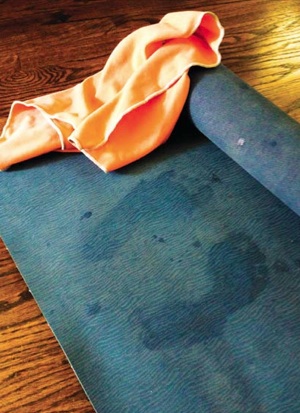 Don’t let your down dog get stinky.
Don’t let your down dog get stinky.
The yoga mat — it’s the prized possession of the modern practitioner.
Dedicated yogis know from experience that as a deep commitment to the practice develops, the mat can begin to transform into a sacred space — one where increasing amounts of quality time are spent. Lives can be greatly impacted by the learning that comes from new realms of awareness and perception within the practice.
However, just as our devotion to yoga starts to grow, something else may be growing on the mat beneath our feet: bacteria, fungus, germs, and everyday odor. Fed by a dedicated (and frequently sweaty) asana practice, these creatures thrive in what might be considered the ultimate yogi petri dish: the yoga mat.
With the variety and quality of yoga mats on the market today, buying a new mat can be a major investment. Protecting this investment by maintaining cleanliness without breaking down the mat can save both money and resources. However, many students who are new to yoga choose to borrow or rent their mats, unsure if they want to commit to a regular down dog, let alone invest in their own yoga mat. Understandably, these students may also be unaware of some basic studio courtesies such as using a towel to absorb their sweat or washing their feet if they have just come from a hike or from the beach.
Overlooking these cleanliness practices is not a phenomenon limited to beginners. After sweating on a mat or yoga towel, one is more than likely to just roll it up and toss it into a dark, stuffy car trunk, creating the perfect environment for bacterial growth and odor build-up. This is something we may fail to notice until a teacher clues us in with a subtle hint. “These are the moments,” says Studio Surya Yoga owner Yonnus Becker, “when I might lovingly spray my Schulze’s Air Detox or use some essential oil to send the message.”
Beyond keeping your mat clean as a courtesy to those around you, concerns about bacteria, fungus, and germs on our mat are real, especially for those of us who may rent or borrow mats at studios and gyms. A 2006 New York Times article interviewed leading dermatologists who found a high correlation between ailments such as athlete’s foot, staph infection, and viral warts on the feet and skin of practitioners who borrowed mats rather than used their own. Although most yoga studios and gyms clean their mats after each use, there are a variety of methods for cleaning mats, which yield varying results. This begs the question: how should we best clean our mats to discourage fungal and bacterial growth while also preventing unwanted odor?
In general, experts recommend choosing products that are harsh on viral, fungal and bacterial elements, but gentle on both the mat material and your skin. Many natural products have been formulated with essential oils, such as tea tree oil, and natural surfactants in order to break down infectious agents without breaking down natural rubber or drying out your mat.
Most of these products are sprayed or wiped on your mat, left to sit for a few minutes to sanitize, and then wiped off with a cloth or sponge and left out to dry. For a deep clean, most mats can be placed in a front-loading washing machine with a small amount of mat cleansing product. Before attempting this, however, make sure you check with your mat manufacturer to see if this could cause breakdown in your specific mat material. Some mats can also be dried on low in a standard dryer, but again, be sure to double-check with the manufacturer.
New technologies are also coming to the forefront. Matsana — a new machine currently employed in several local L.A. studios — uses UV light to disinfect yoga mats. In independent laboratory tests, the UV light used in this technology destroyed 99.9% of all viral and bacterial elements, including staph and e-coli. Studios such as YogaWorks on Montana Avenue use this machine to keep their mats clean for students needing to borrow a mat; it is also available for those who wish to disinfect their own mats. As an added bonus, Matsana is an eco-friendly choice as it disinfects without the use of chemicals or water waste.
As we care for the tools of our practice, such as our yoga mat, and practice courteous class etiquette, we ensure a healthy practice for ourselves and for our fellow yogis. Ally Hamilton, teacher at Yogis Anonymous in Santa Monica, calls this knowledge Sweat Etiquette or “Sweatiquette.” She reminds her students, “The practice of saucha, or cleanliness, has as much to do with personal hygiene as with spiritual purity.”
We can utilize many tools in our practice-kit to help maintain mind-body-spirit health. Practicing saucha on our mat can provide us with a clean and clear understanding of ourselves and the way we affect our environment. With this knowledge, we can continue to tend steadily to our practice, blossoming up from the clean, fertile ground of our yoga mat toward the sunlight of our Higher Self.
Beth Prandini has found both youthful joy and radiant health through the practice of yoga. Diagnosed with Systemic Lupus Erythematosus with a Rheumatoid Arthritis crossover at the age of 19, Beth used yoga to help regulate the effects of her diagnosis. More than a decade of remission has passed for Beth and she graduated with both a B.A. in English/Theater and an M.A. in Education from Pepperdine University. Beth is currently a writer and a YogaWorks Certified Yoga Teacher: bethprandiniyoga.com.
